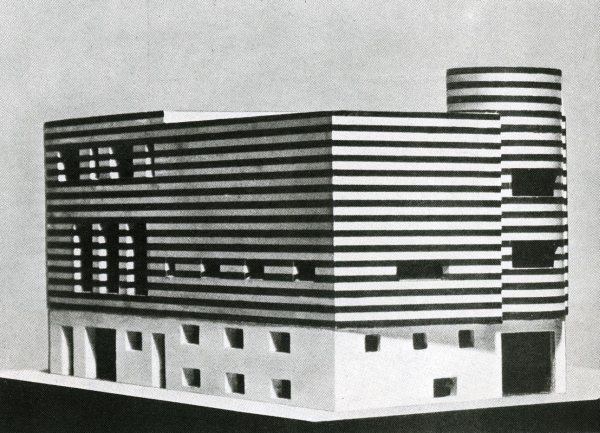Loos, Hundertwasser, Max Ernst
Adolf Loos
MAK, Vienna, 13. 03 – 23. 06. 2013

Adolf Loos: Josephine Baker háza (nem épült meg), 1927, modell: G. Bittorf, M. Burer © Albertina
Loos expert Yehuda E. Safran has developed the exhibition LOOS. Our Contemporary originally for the CAAA Guimarães, Portugal. Based on the example of the oeuvres of architects such as Le Corbusier, Hermann Czech, José Paulo Dos Santos, Eileen Gray, Herzog & De Meuron, Frederick Kiesler, Rem Koolhaas, Richard Neutra, Aldo Rossi, Rudolph M. Schindler, Eduardo Souto de Moura, Ludwig Wittgenstein, and others, the show documents the influence of Loos’ writings and projects on the building culture of the past one hundred years—and examines the eternal efforts to create a balance between inner and outer worlds on the basis of designs, models, furniture, photos and publications as well as interviews.
Contemporary Viennese takes on Loos in the form of works by artists and architects such as Heinz Frank, Karl-Heinz Klopf and Hubmann/Vass Architects will likewise round out this exhibition’s Viennese presentation, as will a retrospective on major Loos presentations and Loos-related research in Vienna.
Hundertwasser, Japan and the Avant-garde
Belvedere, Vienna, 05. 03 – 30. 06. 2013
The work of Friedensreich Hundertwasser is one of Austria’s most significant contributions to art history in post-war modernism. In spite of his immense popularity, which the skilled networker and ambitious artist attained early in his career, the myth of the lone genius and eccentric outsider prevails to this day. In the exhibition Hundertwasser, Japan and the Avant-Garde the Belvedere has set out to rediscover the artist’s early work. A thematic approach places Hundertwasser in the context of the avant-garde movement, aiming to counter this myth and reveal new ways of looking at his art as a whole. In doing so, the exhibition explores the artist’s connections with Japan in the 1950s and his significance within the international avant-garde movement. For the first time in Vienna the show is bringing together masterpieces by Hundertwasser and works by Shinkichi Tajiri, Akira Kito, Yves Klein, Lucio Fontana, Pierre Alechinsky, Constant, Corneille, Sam Francis, and Mark Tobey. Another first is that these artists are being shown with Hundertwasser from the point of view of the Far Eastern influences on their work.
The exhibition is divided into six themes – Architecture, Garden, Japan, The Line, Journey – Way – Process, and Freedom and Abstraction. Architecture addresses Hundertwasser’s plea for individual creative freedom – everybody can, should and must build –, while Garden illustrates his early interest in Japanese garden culture and the ecological awareness this awakened in him. The Line focuses on how Hundertwasser introduced the vegetative spiral, embodying the processes of nature and life in his art, and Journey – Way – Process as well as Freedom and Abstraction demonstrate how the processes of painting, living, and reflection always coincided in his work and free thinking took precedence over art’s formal criteria. For the first time the exhibition is uniting works by Hundertwasser with those of his companions and colleagues, who also found inspiration for their art by studying Far Eastern philosophy.
Max Ernst
Albertina, Vienna, 23. 01 – 05. 05. 2013
The Albertina will devote an exhibition – his first retrospective in Austria – to Max Ernst, the great pictorial inventor. Presenting a selection of 180 paintings, collages, and sculptures, as well as relevant examples of illustrated books and documents, the exhibition will assemble works related to all of the artist’s periods, discoveries, and techniques, thereby introducing his life and œuvre within a both biographic and historical context. Together with Matisse, Picasso, Beckmann, Kandinsky, and Warhol, Max Ernst no doubt numbers among the leading figures of 20th-century art history. An early protagonist of Dadaism, a pioneer of Surrealism, and the inventor of such sophisticated techniques as collage, frottage, grattage, decalcomania, and oscillation, he withdraws his work from catchy definition. His inventiveness when it comes to handling pictorial and inspirational techniques, the breaks between his countless work phases, and his switching back and forth between themes cause irritation. Yet what remains a constant is his consistence in terms of contradiction. Max Ernst was a restless personality who always strove for freedom. Torn between the realization of his personal aims in life and the social and political obstacles during a turbulent period, he nevertheless always looked ahead: a “flight into the future”. A misunderstood and revolting artist, he had moved from Cologne to Paris in 1922, where he joined the circle of the Surrealists; he was detained as hostile alien twice, attempted to get away, and was released thanks to lucky
“coincidences”. In 1941 he escaped into American exile. Remembrance, discovery, recycling, and collage were the combined motor that drove him in his work. Under these aspects, the exhibition positions Max Ernst’s œuvre between references to the past, contemporary political events, and a prophetic and visionary perspective of the future. He who attested to himself a “virginity complex” in the face of empty canvases went always in search of means that would allow him to augment the hallucinatory capacities of his mind, so that visions would arise automatically in order to “rid him of his blindness”.










